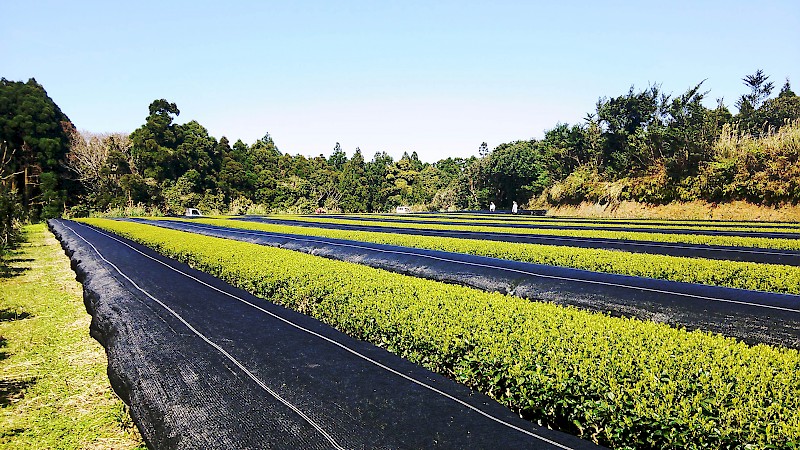MARIMO tea - Manufacture, Import & Wholesale
BLOG - April / May 2017 - Japan Shincha Blog
6th May 2017 – Morimoto Shincha 2017: The Morimotos do their best, that it arrives as soon as possible
Our last trip this year is again to the remote prefecture Miyazaki, to Haruyo and Shigeru Morimoto. Here, the first harvest is in full swing. When we arrive at the Morimoto’s house, Haruyo tells us, that they have been processing all night long. Shigeru did not even sleep for two hours, Haruyo did not sleep at all. Since we know them well, we recognize, that they are a bit tired, but nevertheless they welcome us affectionately und are glad, that we brought visitors.
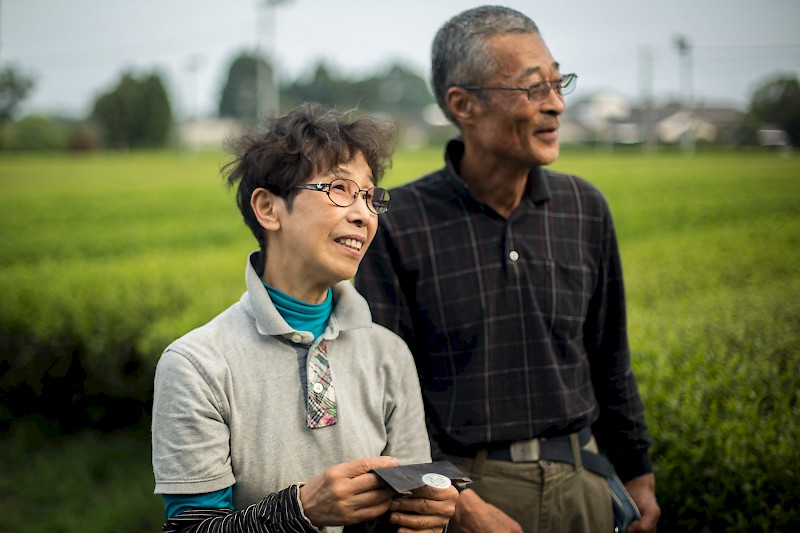
Haruyo and Shigeru Morimoto, visibly touched by the beautiful presents (photo: Arun Herzog)
When we visited a week ago, they already did predict a stressful harvest, however the fact that there is now no sleep at all, is certainly an exaggeration. Yesterday, they harvested and processed yet the Kabuse Yutaka Midori from the tea garden 260 meters over sea level until late night. Since our last meeting, we talked over the phone nearly every day for staying up to date concerning the harvest of this tea. We all longingly wait for this year’s Morimoto Shincha, which at least is already on hand as a pre-processed Aracha. The colour of the Aracha leaves really is great – deeply dark-green, with a slightly blueish gleam – magnificent.
The Yutaka Midori is really late this year. In all of the nine years that we have been working together with the Morimotos, it was never the case, that the harvest of Yabukita and Yutaka Midori are roughly at the same time. Yutaka Midori and Saki Midori have always been the first tea bushes to be harvested, then there was a break of two to three days and only after that, the harvest of the Yabukita began. This year, the harvest of these tea sorts are nearly at the same time. Today, namely the Roji (unshaded) Yabukita, a small part of the Morimoto Tokujou Sencha, was harvested.
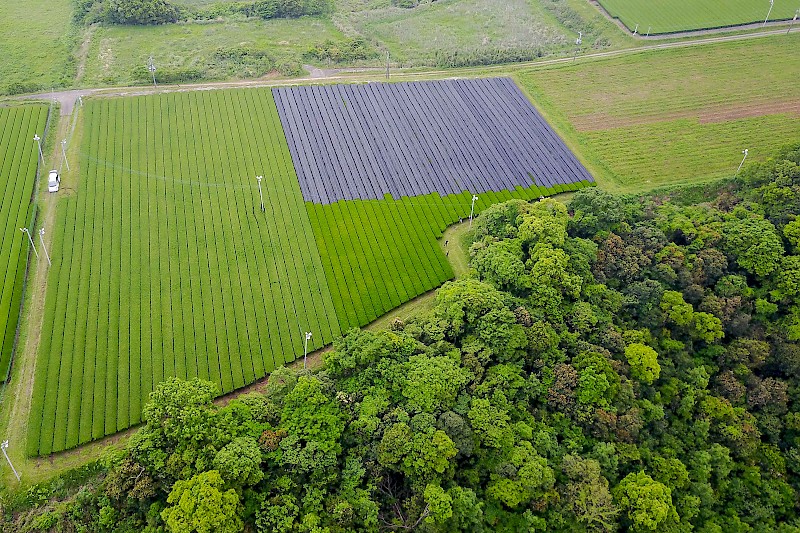
Air photograph of Haruyo and Shigeru Morimoto’s tea garden (left: Kabuse Yutaka Midori, already harvested; middle: Yabukita; right: new plants of Minami Sayaka) (photo: Arun Herzog)
Both the Morimotos and their two daughters did work all night through, therefore they finish early today. Even while we are still there, the two daughters begin cleaning the processing hall. After that, it is filling up energie for the next harvest day. Tomorrow, there will be the harvest of the Kabuse Yabukita, but only if the weather plays along. This year, this is difficult to predict. While we made the experience last year, that the regional weather forecast can predict relatively precise, on which days it will rain and on which days there will be sunshine, this year the weather is very unstable and alternating. Today too, the forecast changed between bright sunshine with 27 degree celsius and heavy rains with 21 degree celsius. Around us, dark clouds stretch over the sky, but coming evening, they vanish instead of releasing the rain.
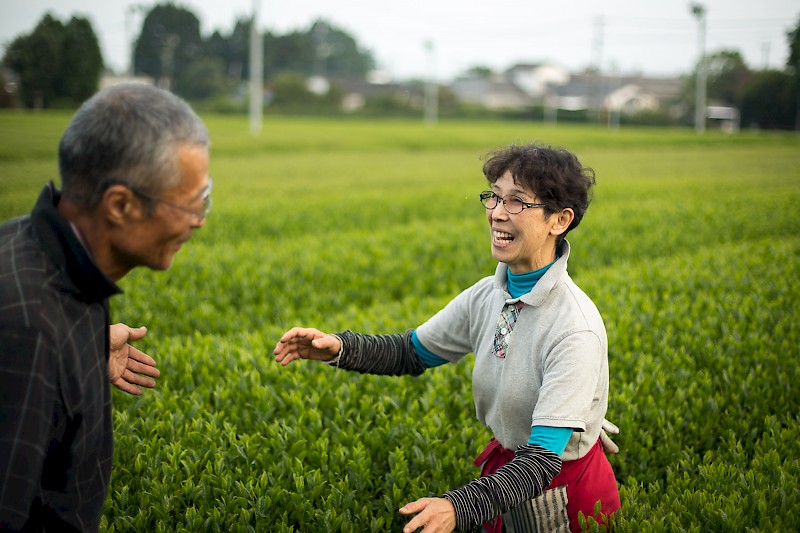
Haruyo and Shigeru Morimoto at the Oku Midori tea garden: Even as old as 68 years, they both kept their youthful energie and vitality (photo: Arun Herzog)
Since we will be on our way back to Honshu tomorrow, we have to depart very early. Haruyo asures us during the farewell, that he will make sure, that the Morimoto Shincha will be sorted as soon as possible and that Shigeru will undertake the final heating as soon as possible, too, so that the tea can be sent to Europe. From monday on, the organic control station works again too – the golden week then comes to an end. Then, also the export certificate can be issued. We will keep you posted about when the Morimoto Shincha hits Europe.
5th April 2017 - Sakura- Shincha MOE: Already on its way to Europe and still here in Kumamoto
Today’s visit at Mr. Matsumoto’s tea garden Sakura-No En allows us again to make a lot of impressive experiences in just a few hours. The welcome is slightly hectic, because Mr. Matsumoto has already a great plan in mind, what he wants to do with us and our costumers. The time slot for our visit is narrow. This morning, Mr. Matsumoto was still processing one part of the Sakura-No Sencha. We now meet him during his break, until he has to work on in the evening. We are very grateful, that we are welcomed so affectionately, even though we came by in the most stressfull harvest time.
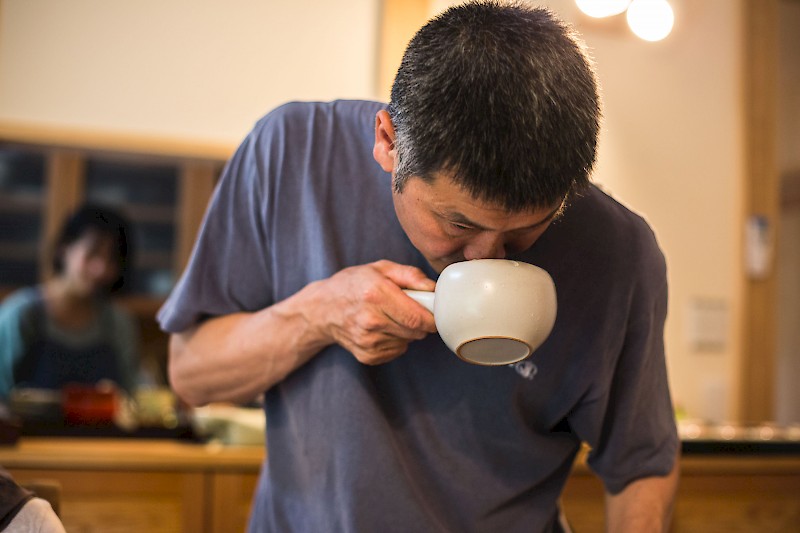
Kazuya Matsumoto while preparing his teas – the smell and the behaviour of the leaves are essential
Kazuya and his wife Satomi Matsumoto pick us up directly at the station and fetch us to the new house of the young family Matsumoto. Here, they both live together with their four children. In the old house, which we were allowed to visit during the last years, live Kazuya’s parents.
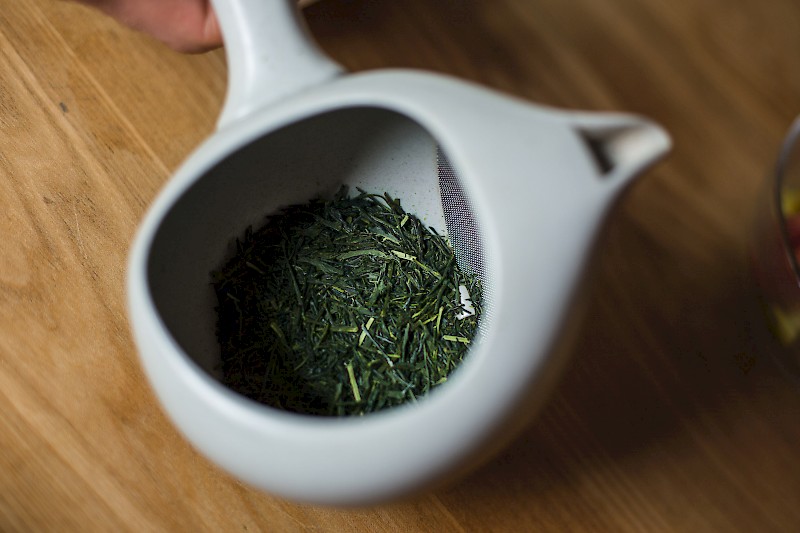
Sakura-No Shincha MOE
After Mr. Matsumoto brought us to the first floor of this idyllic house, he firstly pours us a Shincha MOE, prepared with cold water, which has been harvested just a few days ago. We are lucky, because the amount which is already on its way to Europe is completely reserved for our costumers, so there won’t be anything left for us to taste. Here, on-site in Mr. Matsumoto’s home, we are able to enjoy the freshly harvested Shincha MOE and additionally to taste it together with the local spring water, which is of course a special pleasure.
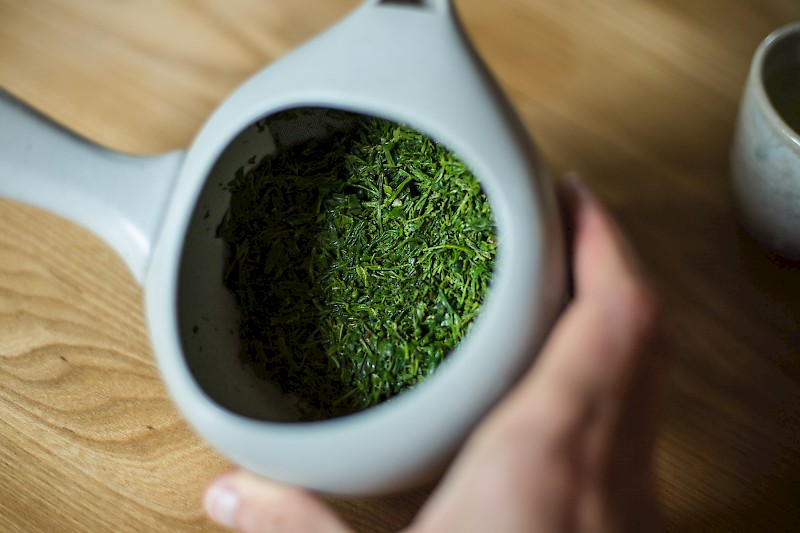
Infused leaves of Sakura-No Shincha MOE
It follows an infusion of the Sakura-No Shincha MOE using Kazuya’s special infusion technique: First, he pours a bit cold water in the open kyusu. After a short period of waiting, he then adds hot water and drains the leaves rather fast. We are once again blown away by the flavour and the intense smell of the Shincha MOE.
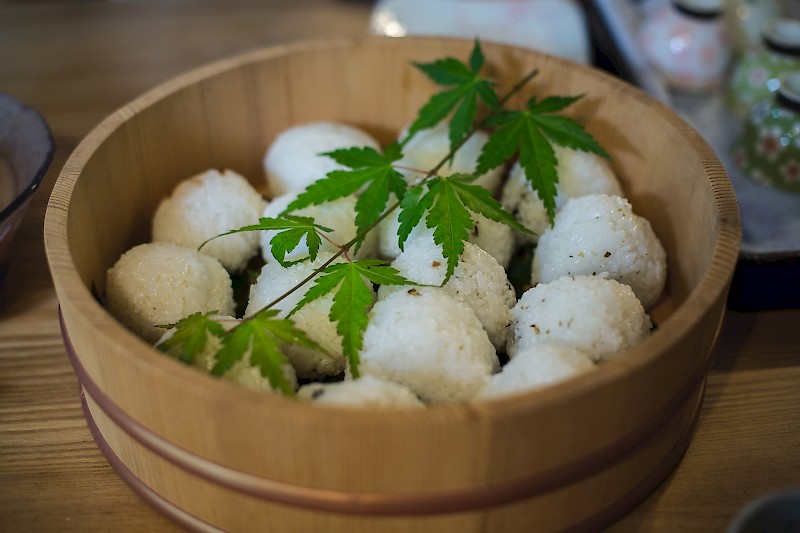
Onigiri from Satomi Matsumoto
While we enjoy the delicous tea, again and again new food, which Satomi Matsumoto prepared for us, appears on the table. Concerning food, the Matsumotos do not only set value on local ingredients, but also think about which sort of tea goes well with which sort of food. These thoughts surely also come from the fact, that the teas from Sakura-No En are being served in some really noble restaurants in Japan.
As completion of this fantastic lunch, we are offered a matcha cake. A confectionary nearby uses one of Sakura-No En’s shaded powder teas for the preparation of this cake. While many cakes in Japan and in Europe too, are rather sweet, so you almost cannot taste anything of the tea’s slight tartness, this matcha cake is only slightly sweetened, so that we are able to enjoy the taste of the tea.
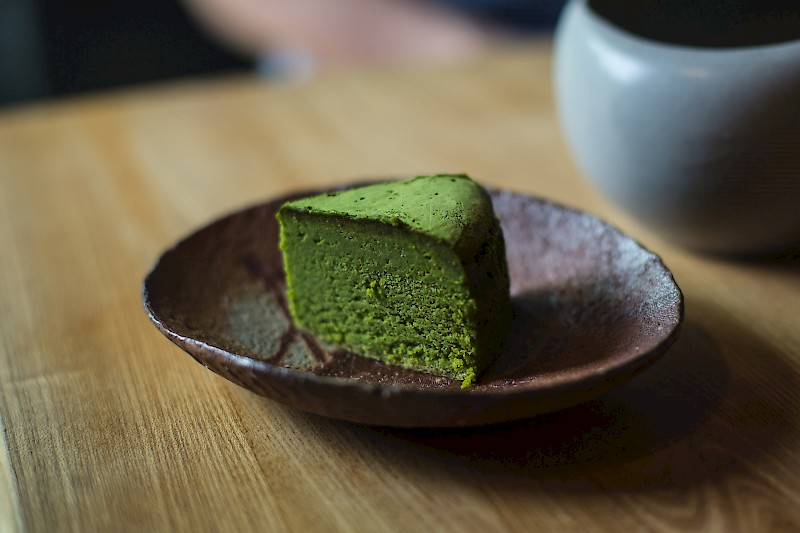
Green tea cake, prepared with powdered tea from Sakura-No En
Well-fed, we now drive to the tea gardens. The gardens higher up, located at 450 to 600 meters over sea level, have not been harvested yet. Here, it is considerably cooler than down in the valley, so the tea bushes generally grow slowlier. The shaded parts for the Sakura-No Sencha, which are being covered for about ten days, are not ready for harvest, too.
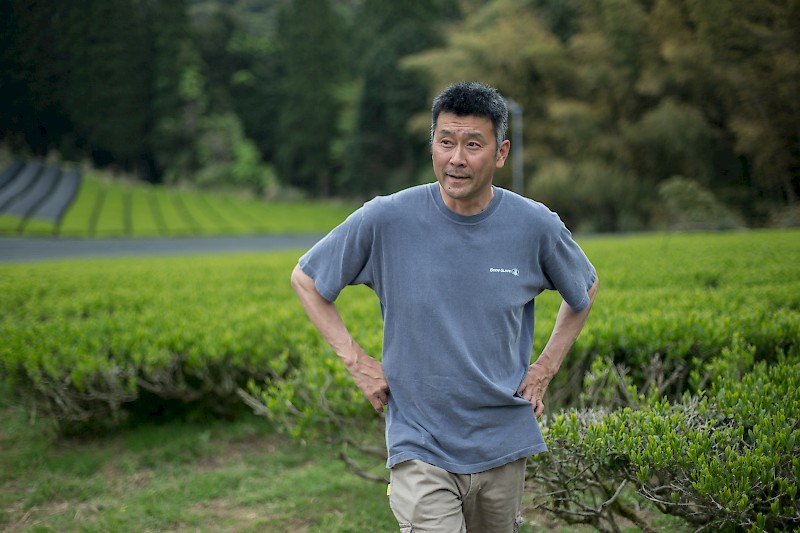
Kazuya Matsumoto in his tea garden
During the ride from one parcel to the next, we drive over narrow twisting roads through a breathtakingly beautiful forest. In between, there are consistently splendid views into distance, which can hardly be more awesome.
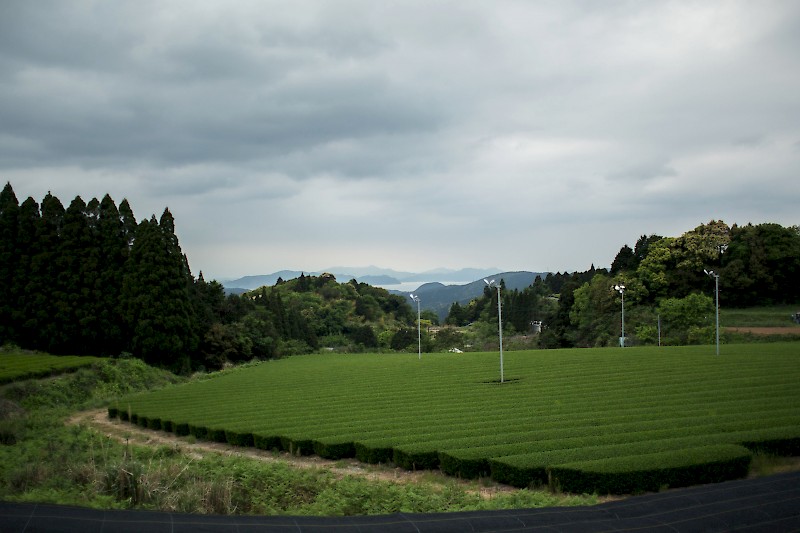
View next to the tea garden Sakura-No En
Driving back, Kazuya shows us some fields of a friend of him, with whom he works together for quite a time now. This young farmer has adopted the bussiness from his father and continues it now in the forth generation. Kazuya Matsumoto succeeded in convincing him, to use, like himself, no pesticides and to produce the tea in a completely natural way. Together with the new harvest we will also get samples from this tea. We are already very excited.
3rd May 2017 – Harvested today and already complete! Shutaro Hayashi’s Kirishima Aracha Shincha
Today, we are at Shutaro Hayashi’s in Kirishima, already the third time in 2017. This year, we are able to follow the whole process from shading to harvest and processing of the new Kirishima Aracha Shincha 2017. Last week, Shutaro Hayashi had more time to spend on us, so that we could wander through the rows of tea together. Today, his father Osamu looks after us, because Shutaro Hayashi turns his attention on the processing of the Shincha.
During our first visit this year on 24th April, Shutaro and Kenji had just finished shading the Asatsuyu cultivar's tea parcel for the Kirishima Tennen Gyokuro. The small Mishou Asatsuyu cultivar's parcel for the Kirishima Aracha Shincha, which lies a little bit isolated, we could look at still without the black nets on this day. On 25th April this parcel too was shaded. Now, eight days later, it is time: The KIRISHIMA ARACHA SHINCHA is being harvested.
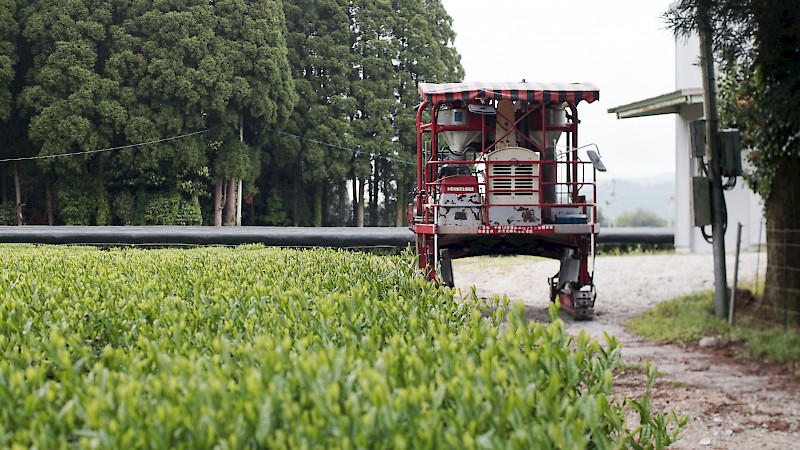
The harvest of the KIRISHIMA ARACHA SHINCHA is finished, the harvesting machine stands next to Shutaro Hayashis processing hall and waits for its next task. (photo: Arun Herzog)
In the morning, we first meet Shutaro’s sister Momoko. Together, we drive to her family’s organic tea garden, which is located at an altitude of roughly 260 meters over sea level. As we arrive at the tea garden, Shutaro and Kenji have been processing the freshly harvested leaves for quite a while. Kenji Hayashi shows us his documentation of the day’s tasks: At 6 a.m. the harvest starts, Kenjis work, at 7.30 a.m. the first leaves arrive at the processing hall. From 8 a.m. on, the fresh tea leaves are being steamed, loosened up, dried and formed into needles. Doing this, Shutaro Hayashi shows all his knowledge and skill. Untill the processing can start, a certain amount of time for heating up the boiler is necessary, so that the water vapor for steaming can be created.
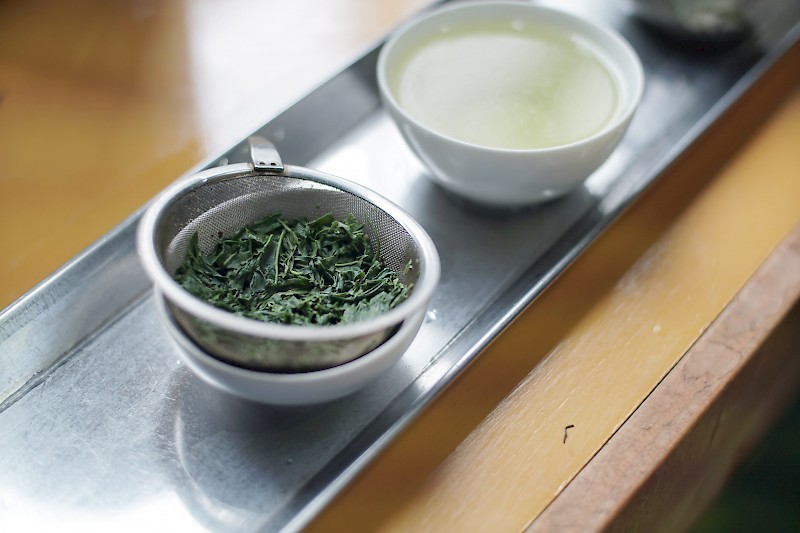
Tasting of the Kirishima Aracha Shincha 2017 on late morning of 3rd May 2017, already infused by Shutaro Hayashi in the processing hall. (photo: Arun Herzog)
Shutaro already shows us the first result of his work. The colour of the leaves is great and the flavour of this pre-processed tea (Aracha) is overwhelming. By the way, what is the difference between an Aracha and a finally processed tea? There are some processing steps later on, which have not happend in the stadium of an Aracha. At this stadium, the tea is not yet sorted. Only a sieve separates large leaves and stipes from the smaller ones. Looking at this year’s KIRISHIMA ARACHA SHINCHA we recognize, that Shutaro harvested very early this year, so he could get an extraordinarily good quality. We can see in this Aracha sample he gave us for tasting, nearly no stipes at all. In addition to the early point of harvest, this can be explained through the nobel tea bush varietal Asatsuyu, which has short internoids and therfore a very small part of Kuki.
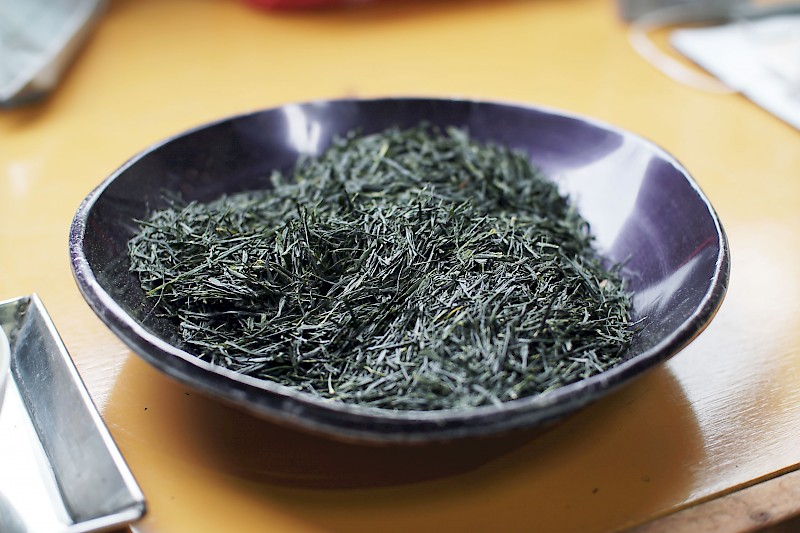
Leaves of Kirishima Aracha Shincha at the tasting on-site, directly after processing (photo: Arun Herzog)
The water content of the Aracha is with 5% remaining humidity slightly higher as of a customary Sencha, which has a remaining humidity of 2%. Concerning flavour, the world of the Aracha is still closer to a fresh tea leave. The glowing green Aracha certainly shows the flavour characteristics of the tea bush cultivar Asatsuyu clearly more than the finally processed tea from the same tea bush sort. Because of the final heating (hi-ire), the characteristics of the tea bush varietal step back.
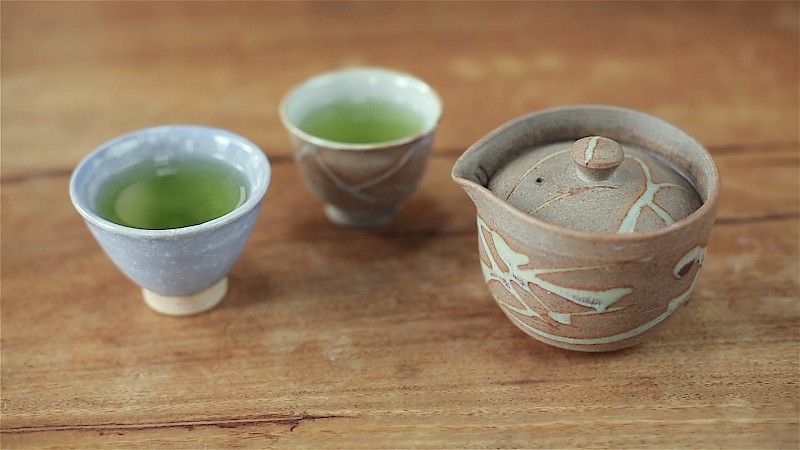
KIRISHIMA ARACHA SHINCHA – Kabuse Asatsuyu cultivar, intense infusion in a kyusu by Narieda Shinichiro for enjoying the tea to the fullest. (photo: Arun Herzog).
Last but not least, we find the time to poure and enjoy the KIRISHIMA ARACHA SHINCHA – Kabuse Asatsuyu cultivar in a real kyusu ( a unique piece of NARIEDA Shinichiro, which differs slightly in form from the tea pots of a smal series from the year 2016). While during the „tasting infusion“ the Aracha Shincha is infused with hot water, so that you can taste all the different nuances, now we infuse it in such a way, that it can be enjoyed perfectly: Many leaves, a relatively low temparature and in a kyusu, which gives it much wealth. It shows too, that this tea – even if it is a Aracha – has lots of umami and tastes round. We take a gasp of relief, because everything did go so well.
29th April 2017 - Debut 2017: KIRISHIMA ARACHA SHINCHA – Kabuse Asatsuyu cultivar
When we were visiting Shutaro Hayashi’s in Kirishima with european customers in the last years, we did get the opportunity to taste Shutaro’s Kirishima Aracha Shincha several times. However, it was not a matter of the same tea bush cultivars every time. In 2016, for example, it was the varietal Asanoka, that Shutaro Hayashi used for his Kirishima Aracha Shincha. Our customer’s feedback was always great, if we tasted the Aracha Shincha on-site at Shutaro’s. Thus, we repeatedly received the proposal from our customers, to import Shutaro’s Aracha Shincha, so that it could be provided in relevant specialised te shops.
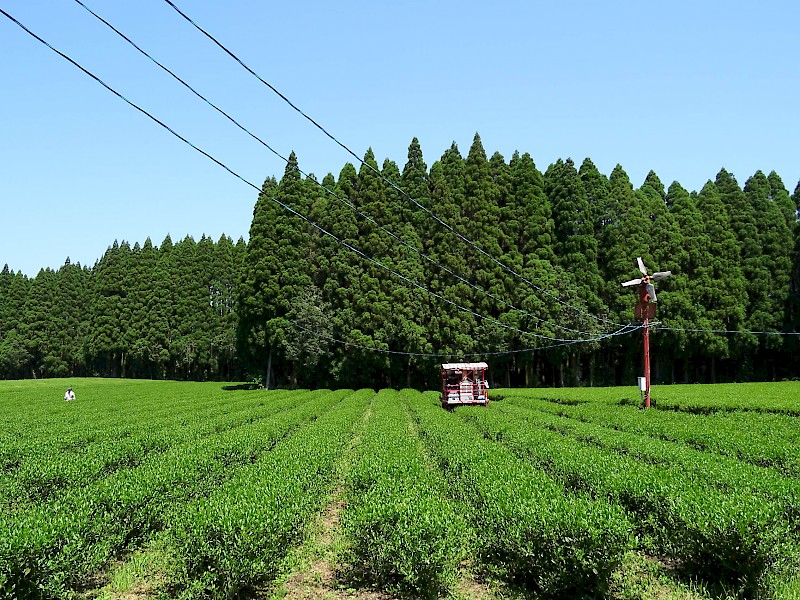
Young Asanoka tea bushes at Shutaro’s Kirishima tea garden
However, Shutaro Hayashi had been equally unsure as we had been at that time, if it were wise to provide an Aracha Shincha in Europe. The background for these concerns was the fact, that because of the deliberately not undertaken final processing to keep the unbelievable freshness of the tea leaves, the leaves are not that much stabilised, since they contain still more humidity. Deep freezed, it would not play a significant role, if the leave material had final processing or not. But as higher the temperature, the more final heating [hi-ire] is acquired to guarantee a stable taste over a time of period such as half a year or a whole year. But both during the transport to our customers in Europe and in most of the specialised tea shops, the tea would not be cooled. Would it thus be possible to obtain the pure and fresh taste of the Kirishima Aracha Shincha until it gets to the people, who want to enjoy it?
With this concerns as background, we did not order the Kirishima Aracha Shincha in the years 2015 and 2016. As the “true taste” of such an Aracha Shincha comes into it’s own only in the first weeks to maximum three months, it would have to get extremly fast from Kirishima to the European tea shops. If the tea is sold directly in Japan and drunk by Shincha fans on-site, that should be an entirely adequate amount of time. But until the tea reached Europe and could be distributed to the specialised tea shops, several weeks would have passed according to experience. However, we kept on thinking…
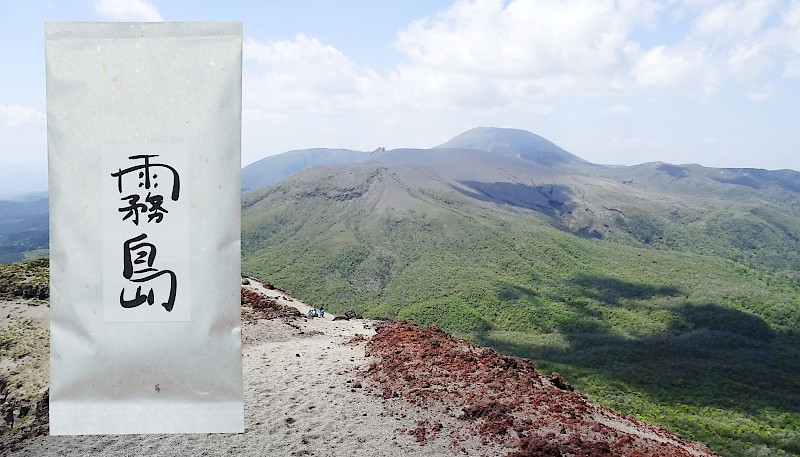
Shutaro Hayashi’s Kirishima Aracha Shincha, made from Kabuse Asatsuyu cultivar
When Shutaro Hayashi came for a visit to Germany and France in spring 2017, in order to perform some tastings at several specialised tea shops, which value his tea, we talked again about the Kirishima Aracha Shincha. We had gotten several samples of Aracha from an other tea garden in 2016, which we tried some months later. We realized, that the quality had not changed as heavily as we had anticipated. Additionally, we had the thought to work with a very small amount, that Shutaro would produce especially for us. This small amount could be transported by us via our luggage when we returned from our trip through Japan, so as to keep the leaves as fresh as possible and to be able to provide them in Europe as quickly as possible. So we talked about our idea with Shutaro in march 2007 and he was instantly excited.
Now we simply had to settle, how precisely the KIRISHIMA ARACHA SHINCHA 2017 should be produced. An other subject to be cleared was, out of which tea bush variety this tea should be made. As Shutaro’s preferences lie with the two tea bush varietal Asatsuyu and Asanoka at the moment, he instantly proposed to use one of these two tea bush varieties for the Kirishima Shincha. When we met at his tea garden the last days in April 2017, Shutaro Hayashi showed us the tea bushes of the variety Asanoka, which he planted in his tea garden several years ago, next to the small building, where he processes his tea. As compared to the year 2013, when we had seen these Asanoka bushes the first time, they have grown substantially since and you can see, that they feel very comfortable at Shutaro’s. However, Shutaro’s Asanoka bushes are still too young and sensible to be shaded, which you can see by the fact, that they have not yet grown together as a row. Until they are ready, surely one or two years will pass. Hence the “KIRISHIMA ARACHA SHINCHA” should be processed from shaded bushes [kabuse sabai] according to Shutaro, the Asanoka is still out of question this year.
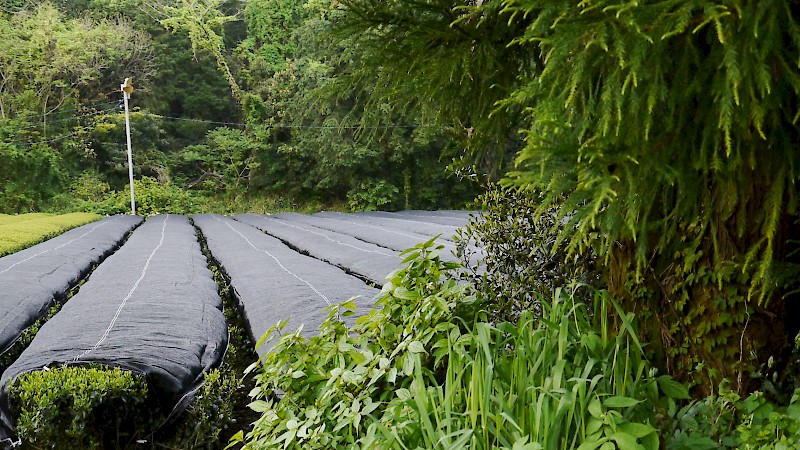
Mishou tea garden, already shaded for Kirishima Aracha Shincha
Shutaro’s decision concerning the tea bush variety for the KIRISHIMA ARACHA SHINCHA 2017 was on the tea bushes of the varietal Asatsuyu. Though, like marginally mentioned before, there is more to say about these selected Asatsuyu bushes. The sort “Tennen Gyokuro” produced by Shutaro Hayashi out of the cultivar Asatsuyu, comes from leaves of Asatsuyu bushes in his tea garden, which were really cultivated from cuttings of the tea bush varietal Asatsuyu. That is, it is a question of tea bushes, that have been cultivated from cuttings of a Asatsuyu bush and are by that identical from a genetical perspective. Concerning the Asatsuyu cultivar's leaves for the KIRISHIMA ARACHA SHINCHA 2017, the process is different.
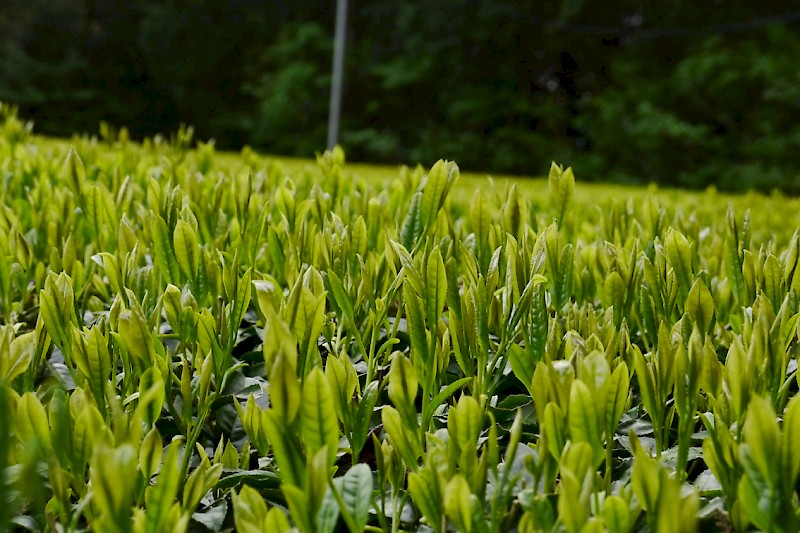
Kirishima Asatsuyu Cultivar's Mishou for Aracha Shincha, before being shaded
If you look at the picture we took shortly after the 20th April in Shutaro Hyashi’s tea garden in Kirishima, there are three chraracteristics that come to the eye, indicating, that it is about Asatsuyu tea bushes: First, the leaves are relatively small and thin. Second, the colour of the leaves is a beautiful glowing green. Though, considering these characteristics, it could still be some other bush varieties’ leaves. But the third characteristic points very clearly towards Asatsuyu bushes, for the really young and small leaves are coloured slightly red at the upwards growing tips. This is a very specific characteristic of the Asatsuyu tea bush varietal. If you shade the Asatsuyu bushes like Shutaro did during the last days, however, the redish tips vanish and change completely into a intensiv light green. But what is the difference between the Asatsuyu bushes used for Tennen Gyokuro and the Asatsuyu bushes Shutaro uses this year for the KIRISHIMA ARACHA SHINCHA?
On the picture above you can see, that the tea bushes from this particular Asatsuyu cultivar's tea garden owned by Shutaro Hayashi, are not completely uniform. The bushes do not show such heavy differences like the bushes in a zarai garden, that is a tea garden containing bushes cultivated out of seeds with unknown parents. In these gardens, the tea bushes show great differences in growth and very different shapes, colours and sizes concerning the leaves. The tea bushes from Shutaro Hayashi’s Mishou Asatsuyu cultivar's tea garden do not show the perfect uniformity of a single variety tea garden cultivated out of cuttings of a single tea bush variety. However, they are not either as diverse as the bushes in a zarai tea garden. Between the single bushes, there are only surprisingly little differences concerning the shape, colour and size of the leaves. Interestingly, the growth is largely consistent, so that the tea bushes in Shutaro’s Mishou tea garden have sprouted to nearly the same length. Like Shutaro says it short and pragmatic: “All in all, they are Asatsuyu bushes, also concerning their characteristic taste, however, it is not a pure Asatsuyu cultivar. Thus, I call this tea garden “my special Asutsuyu tea garden””. Presumambly, the point of time when the fresh sprouts grow is passed down from the mother’s side, because the mother of all of these plants is the Asatsuyu cultivar.
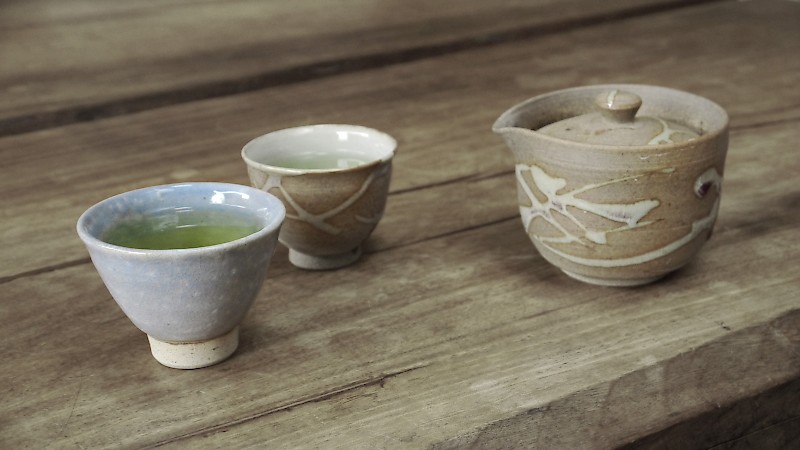
Shutaro Hayashi’s Kirishima Aracha Shincha
(As we took the picture above already on 27th April 2017 and therfore still several days before the harvest of Kirishima Aracha in 2017, the tea used here is from the 2016 harvest.)
The question concerning what kind of a tea garden this one is, if it cannot be a single varietal Asatsuyu, but consists neither of zarai bushes, can be very simply answered: It consists of Mishou bushes of the cultivar Asatsuyu and it is a tea garden cultivated from seeds. However, while a zarai tea garden is cultivated from seeds whose origin is unclear, this is not the case with these Mishou bushes. With Mishou bushes, the variety of the mother plant (egg cell) is definit, but the variety of the father plant (pollen) is unknown. For a Mishou tea garden, the seeds are being collected from a single tea bush variety. As the female blossoms from this bush are being pollinated with pollen from other bushes, the following generation shows many similarities, but because of the combination with different father plants, it shows some differences, too. The leaves Shutaro Hayashi uses for the KIRISHIMA ARACHA SHINCHA 2017 come therefore from Mishou bushes of the varietal Asatsuyu. This means, that they are very similar to the single cultivar Asatsuyu bushes concerning both formality and taste. But they do also have other nuances, which you can only find in Shutaro Hayashi’s Mishou Asutsuyu tea garden.
The KIRISHIMA ARACHA SHINCHA 2017 is thus not only a Shincha which is exciting for being available in the stadium of Aracha, but also because no one could produce such a Shincha. The Mishou Asatsuyu bushes in this particular form exist only in Shutaro Hayashi’s tea garden, since Mishou bushes are as unique like any child in this world, because of natur’s principles. The fact that Shutaro also shades his Mishou Asatsuyu bushes, gives this tea even more sweetness and umami, additionally to the freshness and sweetness which the varietal Asatsuyu is already known for. The straight and pure flavour of the Aracha leaves which are not yet finally processed and therefore rather raw, make this tea clearly more exciting and guarantee a certain degree of shibumi, which gives this tea its natural character. And well, it is a tea which is produced by Shutaro Hayashi and bears thus his master’s signature.
27th April – Sakura-no Shincha MOE update: Mr. Matsumoto harvested
Finally, it is happening: This morning, Mr. Matsumoto from the tea garden Sakura-No En called with the good news, that he harvested the super fine leaves for the Shincha MOE two days ago. The harvest date for the Sakura-No Shincha MOE is thus 25th April 2017. After the producing of the Aracha, which happend first, yesterday on 26th April also the Sincha MOE 2017’s final processing (shi-age) took place. Like fans of Shincha MOE probably already know, this Shincha is harvsted so fine, that there is no final sorting. There is nothing, that could or should be sorted. However, the final step of the shi-age takes place, in this case just not in the meaning of a final sorting, but in the meaning of a final heating (hi-ire). To be specific, the Shincha MOE is not a Aracha-Shincha, but a finally processed Shincha.
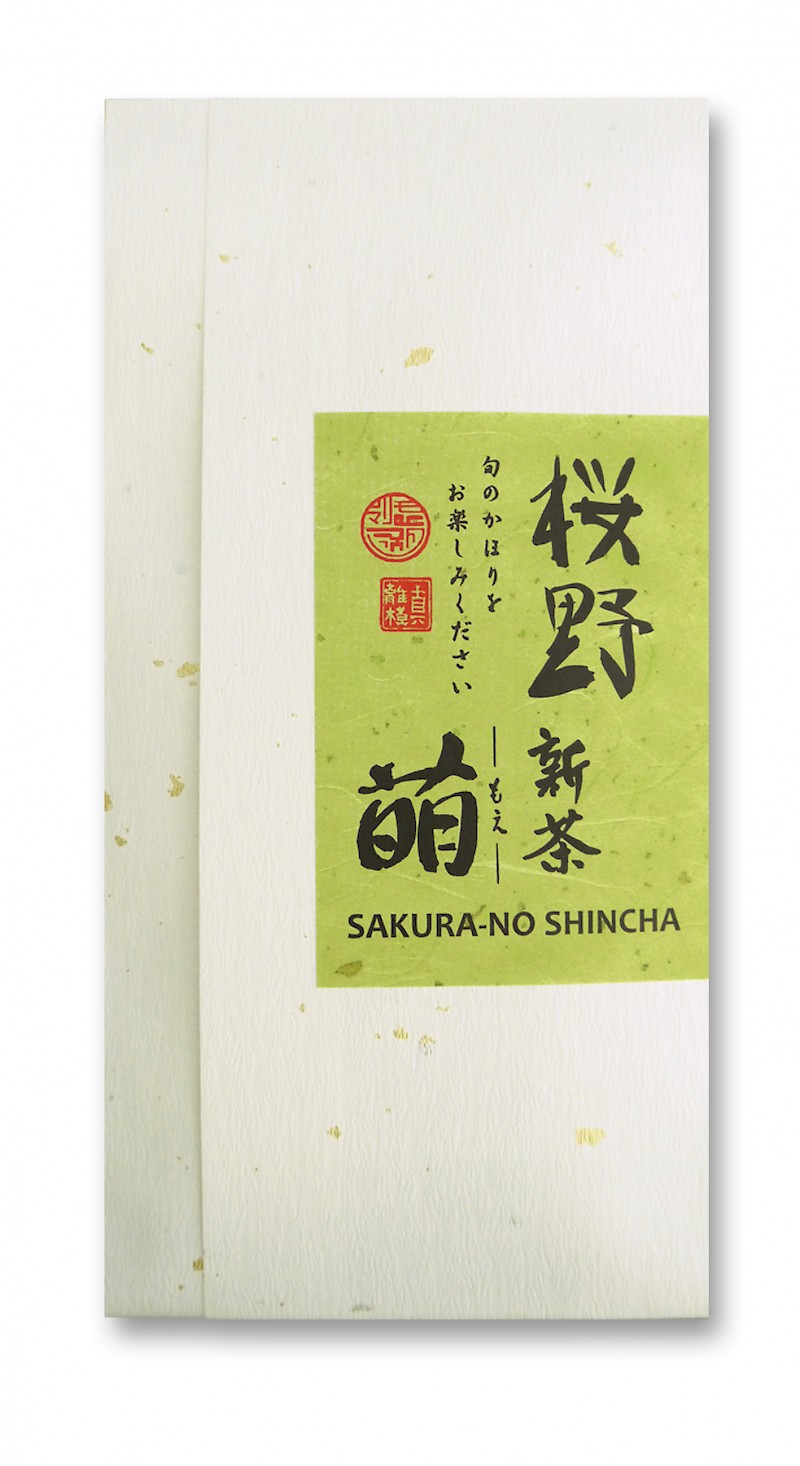
Mr. Matsumoto’s Sakura-No Shincha MOE 2017
Thanks to the glad call from Mr. Matsumoto, we could directly confer with him. Because of that, it worked out, that he could send the Shincha MOE 2017 to Frankfurt via air cargo, like it is common for this sort of tea, on 27th April, that means only two days after the harvest.
Thus, the Shincha MOE will arrive shortly at Frankfurt and there, it will be available in all tea shops, which did make a reservation with us for Shincha. We too are really excited and look forward to try it, as soon as we are back in Germany. Possibly, our customers will have the opportunity to try this great Shincha even earlier than us. That makes us happy, because we did have the enjoyment of breathing the fresh "Shincha air" here in Kyushu on a daily basis after all.
22nd April 2017 - Watanabe Kabuse Yutaka Midori Shincha Update & Shutaro Hayashi’s Kirishima Asatsuyu bushes
This morning, we called Mrs. Watanabe at Yakushima, who happily anounced that yesterday, meaning on 21st April, also the Kabuse Yutaka Midori was harvested and processed. It is extraordinary that this year, the Asatsuyu bushes had been harvested before the Yutaka Midori. In the last years, it was always the other way around.
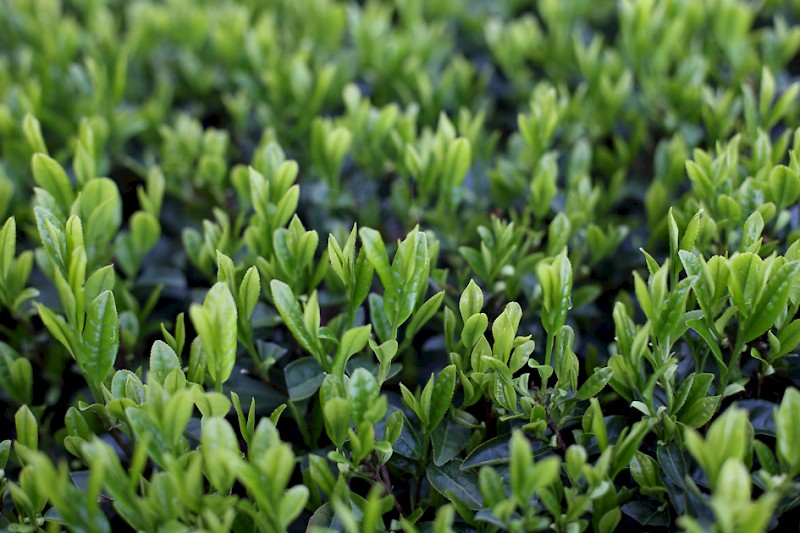
The Kirishima Asatsuyu bushes at Shutaro Hayashi’s organic tea garden
From Shutaro Hayashi too, there are news concerning his marvellous Kirishima Asutsuyu cultivar. You best look for yourselves, how beautifully the tea bushes sprouted. For the next days, there are no forecasts for rain in Kirishima, so the tea bushes grow very slowly because of the mild temperatures by day and the rather chilly nights with temperatures only in the single-digit zone. In the middle of next week, there shall be rain again. This sounds like really ideal conditions for a great tea.
Shutaro Hayashi's Kirishima Asatsuyu cultivar's tea garden
Table of the Shincha harvest 2017, status 22nd April 2017
|
location |
tea garden |
tea bush varietal |
estimated date |
|
South-Kyushu, Kagoshima Prefecture, |
Kuritawase cultivar |
harvested on 13th April 2017 |
|
|
South-Kyushu, Kagoshima Prefecture, |
Yutaka Midori cultivar |
harvested on 21st April (later than usual for Yutaka Midori) |
|
|
South-Kyushu, Kagoshima Prefecture, |
Sae Midori cultivar |
harvested on 15th April 2017 |
|
|
South-Kyushu, Kagoshima Prefecture, |
Asatsuyu cultivar |
harvested on 15th April 2017 |
|
|
South-Kyushu, Miyazaki Prefecture |
Yutaka Midori cultivar |
estimated 28th April |
|
|
South-Kyushu, Miyazaki Prefecture |
Saki Midori cultivar |
estimated 29th April |
|
|
South-Kyushu, Kumamoto Prefecture, |
Yabukita cultivar |
estimated 28th April |
|
|
South-Kyushu, Kagoshima Prefectur, region Kirishima |
Asatsuyu cultivar |
estimated 30th April |
|
|
Honshu, Mie Prefecture, |
Yabukita cultivar |
estimated 10th to 20th May |
|
|
Honshu, Shizuoka Prefecture |
comparative tea garden |
Yabukita cultivar |
estimated 22th May |
20th April 2017 – Shincha update: MOE on 18th April 2017 and the race of the tea varietals
In the last days, we have been en route in several trains even longer than usually, today we actually traveled till Kyushu. Hence we we were not able to post the new pictures from the tea gardens here in the Shincha blog 2017 on time. But now, we are going to catch up quickly.
In the following, you can find a picture of Mr. Matsumoto, showing how the leaves of the Yabukita bushes for the Shincha MOE look like on 18th April – that means 10 days after we showed the first picture of Mr. Matsumoto’s shincha tea garden.
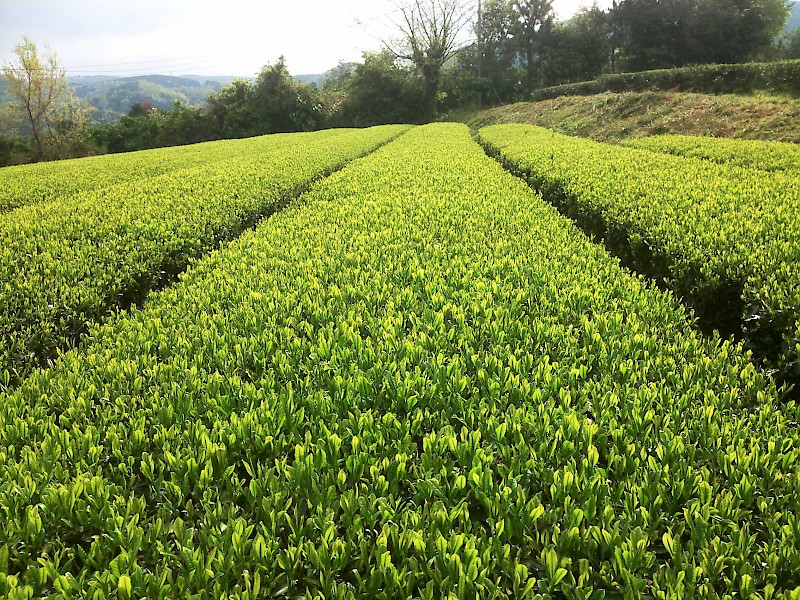
Mr. Matsumoto’s Yabukita bushes for Shincha MOE, picture taken on 18th April 2017
While the harvest of the Shincha MOE at Mr. Matsumoto’s is delayed, like anounced, by about 10 days in comparison to average years, with family Watanabe the case is clearly more complicated. Why that?
At Mr. Matsumoto’s, the Shincha MOE is produced only from a single tea bush variety, namely the Yabukita bushes. The interessting point that defines the Shincha MOE, apart from Mr. Matsumoto’s philosophy of growing tea, is the extremly fine cut. Mr. Watanabe though works differently with his Shincha sorts. For them, he uses several different tea bush varieties, which he combines for his Shincha sorts in several ways.
Table of the Shincha harvest 2017, status 20th April 2017
|
location |
tea garden |
tea bush varietal |
estimated date
|
|
South-Kyushu, Kagoshima Prefecture, |
Mankichi Watanabe’s organic tea garden
|
Kuritawase cultivar |
Harvested on 13th April 2017 |
|
South-Kyushu, Kagoshima Prefecture, |
Mankichi Watanabe’s organic tea garden
|
Yutaka Midori cultivar |
Harvest later as it is usual for Yutaka Midori - waiting for latest news |
|
South-Kyushu, Kagoshima Prefecture, |
Mankichi Watanabe’s organic tea garden
|
Sae Midori cultivar |
Harvested on 15th April 2017 |
|
South-Kyushu, Kagoshima Prefecture, |
Mankichi Watanabe’s organic tea garden
|
Asatsuyu cultivar |
Harvested on 15th April 2017 |
|
South-Kyushu, Miyazaki Prefecture |
Haruyo and Shigeru Morimoto’s organic
|
Yutaka Midori cultivar |
28th April |
|
South-Kyushu, Miyazaki Prefecture |
Haruyo and Shigeru Morimoto’s organic
|
Saki Midori cultivar |
29th April |
|
South-Kyushu, Kumamoto Prefecture, |
Kazuya Matsumoto’s
|
Yabukita cultivar |
28th April |
|
Honshu, Mie Prefecture, |
Iwao Hayashi’s
|
Yabukita cultivar |
10th to 20th May |
|
Honshu, Shizuoka Prefecture |
comparative tea garden |
Yabukita cultivar |
22th May |
The tea bush variety Kuritawase, which sprouts early every year, has been the first tea bush variety to be harvested this year, too. But only two days later, the varietals Asatsuyu and Sae Midori followed as second and third variety, concerning time of growth. This is surprising, because in the last years, the Asatsuyu cultivar's harvest was delayed several times by nearly a week, after the variety Yutaka Midori had been harvested long ago. This year though, the varietal Asatsuyu is harvested proportionally early and the variety Yutaka Midori, which is known for a very early sprouting, is delayed. The climatic differences, concerning warmth, solar irradiation and the amount of rainfall, thus affect the the tea bush varieties’ growing cicles in different ways, so that their temporal point of harvest is delayed not only absolutely, but also proportionally to each other.
18th April 2017 - Kirishima: Time for Shincha? News from Shutaro Hayashi
Something we did not yet mention in this Shincha blog is, how the term "Shincha" respectively the tea sort "Shincha" is actually defined. So, befor we take a look on the latest status of the Asatsuyu tea bushes in Shutaro Hayashi's tea garden in Kirishima, we will give you an explanation on the definition of the term "Shincha":
Shincha
1. Definition
The term “Shincha” consists of the two Japanese words “shin” (new) and “cha” (tea). Translated literally, Shincha thus means “new tea”. Concerning the quality of a Shincha, meaning: what distinguishes it from other sorts of Japanese tea, there are two different definitions:
(A) Shincha as a term for tea, which has just been newly harvested
In Japan, small labels with the inscription “Shincha” are often placed on the sorts of tea from the first harvest, directly after they have been harvested. Outside of Japan, you do not find this practice in selling tea very often. With this small labels, mostly fine sorts of Sencha or Kabusecha, in some extent also sorts of Kukicha are marked. Of course, this is not uniform in all tea gardens or with every retailer. After a few weeks, the same sorts of tea are still being sold, but then without the small Shincha-labels. In this case, the description “Shincha” reveals nothing about the quality of the tea or a certain way of producing, but only the fact, that this is the freshly harvested tea of the first harvest.
(B) Shincha as a independent sort of tea
In Japan as well as outside of Japan, you can find “Shincha” as a description for a independent sort of tea. In this case, a Shincha can have (but does not have to have) one or several of the following characteristics:
- The leaves for the Shincha are being harvested especially early, when the tea bushes have not yet grown enough for the first regular harvest (this surely is a criterion, which can be found very often).
- The leaves are being harvested from sorts of tea bushes, which sprout especially early (that means, they do not “grow faster”, because the growing-cycle is merely delayed. Thus, these are not tea bush varieties, that grow faster or have a higher amount of harvest.)
- The harvesting machine is adjusted in a way, that only the finest leaves are being harvested.
- The final heating [hi-ire] happens only a short period of time or with a relatively low temperature, so that Shincha sorts, which are produced this way, taste especially fresh and spring-green. However, as lower the hi-ire, the more sensible the tea becomes, so that a only slightly heated Shincha should be drunk so much faster.
And now, we will get to the current status of the Asatsuyu tea bushes at Shutaro Hayashi’s tea garden in Kirishima.
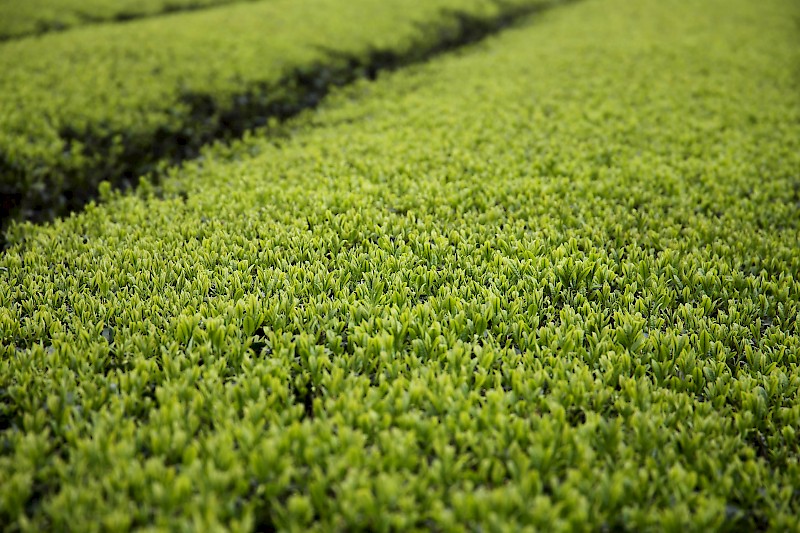
Shincha sprouts of the tea varietal Asatsuyu at Shutaro Hayashi’s tea garden in Kirishima
Characteristic for the Asatsuyu tea bushes, which you can see in the picture above that Shutaro Hayashi took this morning (18th April 2017) in his tea garden in Kirishima, is not only the bright spring-green colour of the leaves, which show an even lighter green than most of the tea bushes do. Also typical is the noticeably small size of the leaves, which is attended by the fact, that the Asatsuyu bushes produce considerably more leaves than other tea bushes. Additionally, the small size of the Asatsuyu cultivar's leaves and their rather soft quality is attended by a very small thickness. This has the effect, that during the process of steaming, the steam goes proportionally deep into the inside of the leaves. Thus, the result is often a rather deeply steamed leave of the cultivar Asatsuyu, how we also know it from the tea Tennen Gyokuro, produced by Shutaro Hayashi from the tea bush cultivar Asatsuyu. Certainly thanks to the high quality of this admirable tea, Tennen Gyokuro has already reached a high level of popularity in this country.
But: Even if Shutaro Hayashi will produce Tennen Gyokuro from the Kabuse Asatsuyu cultivar again this year, doesn’t he maybe have new ideas already for creating an additional new sort of tea with these leaves?
15th April 2017 - Watanabe Shincha 2017: update on the cultivars Kuritawase & Asatsuyu
Yesterday we received a new picture from Mr. Matsumoto from the prefecture Kumamoto. On this picture you could see the progress of the young sprouts at the particular tea garden parcel, from whose tea bushes he harvests the leaves for the fabulous Shincha MOE. Today we will look at the latest Shincha news at the island Yakushima.
Mrs. Goto, employee at the tea garden of Mankichi Watanabe and his son Keita Watanabe, let us just know, that on 13th April the first part of the Kuritawa tea bushes has been harvested. Two years ago, we were able to witness how the leaves of the tea bush variety Kuritawase were harvested at Mr. Watanabe’s tea garden as early as at the end of March - an extraordinary early harvest year in 2015. Now, in 2017, the harvest year is quite late and the tea bush variety Kuritawase has actually been harvested first on 13th April, although it is the tea bush variety, which sprouts earliest at Mankichi Watanabe’s tea garden and which he uses for our “Watanabe Kabuse Shincha“.
All the more interessting is the fact, that the temporal relations compared to the different tea bush varieties change, too. While in the year 2015, the harvest of the Kuritawase tea bushes took place at the end of March, the tea bush varietal Asatsuyu was harvested nearly two weeks later, in the middle of April. Thus the temporal difference between the cultivars Kuritawase and Asatsuyu was just under two weeks. This year, in 2017, however, the first leaves for Watanabe Kabuse Shincha were harvested as late as 13th April. But Mrs. Goto explained to us, that the 15th April, meaning today, was the second harvest day and that now the second part of the Kuritawase bushes as well as the first part of the tea bush varietal Asatsuyu are being harvested.
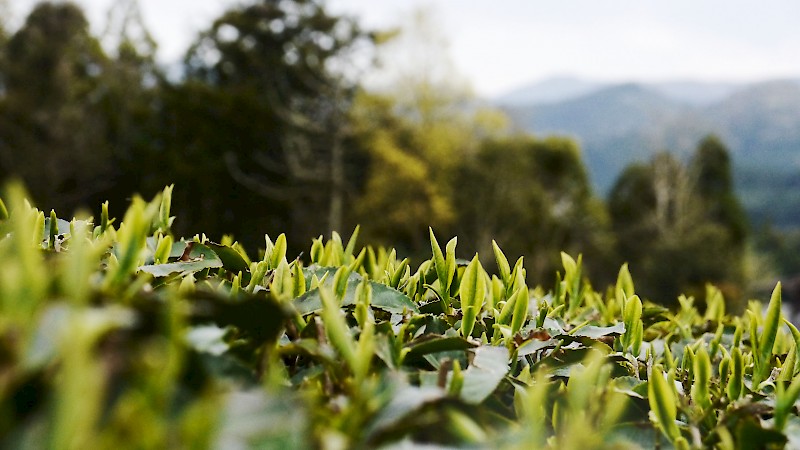
Iwao Hayashi’s tea garden at Mie Prefecture
In comparison, here is a picture we took today at the organic tea garden of Iwao and Kimihiko Hayashi at Mie Prefecture. The prefecture Mie lies roughly at the same altitude as Nagoya, that means just a bit more than one hundred kilometres from Kyoto Prefecture. Hence Mie Prefecture lies six-hundred to seven-hundred kilometres north from Yakushima, where the first Shincha has already been harvested two days ago. But here, in Mie, you can’t actually see anything but the very first, extremely small sprouts. While the son, Kimihiko Hayashi, rated 10th May as the first harvest day, his father’s, Iwao Hayashi’s rating was 20th May, as this year, it is still quite chilly in Mie.
14th April 2017 - Shincha MOE: News from Mr. Matsumotos tea garden
Some minutes earlier, we received the latest news from Mr. Matsumoto, who currently takes a picture from his tea garden nearly every day and sends it to us. These pictures always show the particular tea garden parcel, from whose bushes Mr. Matsumoto takes the leaves for the Shincha MOE. That way you can excellently witness, how the fine, young sprouts grow further. Step by step they sprout, until they have reached the perfect size and quality for being harvested by Mr. Matsumoto for his Shincha MOE.
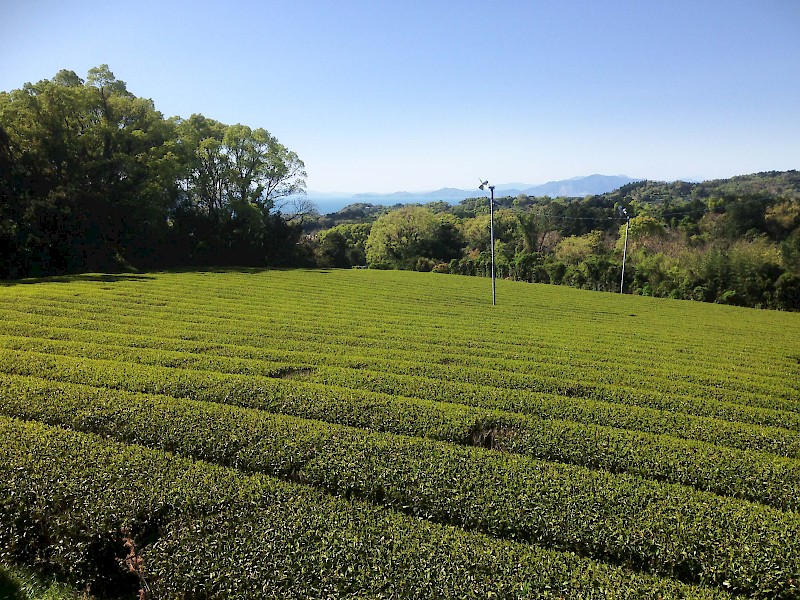
A picture of the particular tea garden parcel, where the leaves for the Shincha MOE are from, taken by Mr. Matsumoto on 14th April 2017.
The distinctively lovely tea garden, where Mr. Masumoto cultivates the Yabukita bushes, whose leaves he uses in a very early phase of growth for the extraordinary fine Shincha MOE, can easily be recognized: In the backgroung, you see an idyllic lagoon, located in the prefecture Kumamoto.
From Mrs. Goto, an employee at the tea garden belonging to Mankichi Watanabe and his son Keita Watanabe, we got a message today, too. She informed us about how the tea bushes are developing and which tea bush variety for the Shincha will be harvested presumambly at which day this year or which ones have already been harvested. More information on this we will write in the next blogpost here on Shincha Blog 2017.
13th April 2017 - Shincha 2017: The influencing factors location, tea bush variety and style of production
Yakushima Island is the producing area with the earliest Shincha harvest throughout Japan, aside from Okinawa, which lies even further south. At Mankichi Watanabe’s tea garden in Yakushima, the young tea leave sprouts have grown several centimeters already. In contrast, in northern Japanese tea producing areas, like Shizuoka or Saitama, not a single sprout of the new harvest can be seen. Below, we tried to gather in a table the time dimensions of the various areas where Shincha is produced. Certainly, the list is not complete: we do have close contact to tea gardens in many Shincha-producing Japanese prefectures, but not to tea gardens in all of the Japanese tea producing prefectures.
Table of the Shincha harvest 2017, status 13th April 2017
|
location |
tea garden |
tea bush varietal |
estimated date
|
|
South-Kyushu, Kagoshima Prefecture, |
Mankichi Watanabe’s organic tea garden
|
Kuritawase cultivar |
13th April, HARVESTED TODAY |
|
South-Kyushu, Kagoshima Prefecture, |
Mankichi Watanabe’s organic tea garden
|
Yutaka Midori cultivar |
14th April |
|
South-Kyushu, Kagoshima Prefecture, |
Mankichi Watanabe’s organic tea garden
|
Sae Midori cultivar |
16th April |
|
South-Kyushu, Kagoshima Prefecture, |
Mankichi Watanabe’s organic tea garden
|
Asatsuyu cultivar |
17th April |
|
South-Kyushu, Miyazaki Prefecture |
Haruyo and Shigeru Morimoto’s organic
|
Yutaka Midori cultivar |
28th April |
|
South-Kyushu, Miyazaki Prefecture |
Haruyo and Shigeru Morimoto’s organic
|
Saki Midori cultivar |
29th April |
|
South-Kyushu, Kumamoto Prefecture, |
Kazuya Matsumoto’s
|
Yabukita cultivar |
28th April |
|
Honshu, Mie Prefecture, |
Iwao Hayashi’s
|
Yabukita cultivar |
20th May |
|
Honshu, Shizuoka Prefecture |
comparative tea garden |
Yabukita cultivar |
22th May |
Concerning the question at which point the leaves for a Shincha should be harvested, a lot of different factors play a significant part.
First, there is the factor of the producing area: there is large difference in harvest timing between southern and northern producing areas. In this regard, Kyushu lies furthest in the south of Japan. Here, many well-known tea producing areas can be found, like Kirishima, Satsuma and Yakushima in Kagoshima Prefecture plus other tea prefectures which are nearly as well-known by now, like Miyazaki, Kumamoto, Saga and others. Further north lies the island Honshu, which however stretches several hundred kilometers from southwest to northeast. The tea producing areas Nara, Kyoto and Mie are relatively far in the south of Honshu, but they are still several hundred kilometers north from Kyushu. Shizuoka and Saitama are part of the northernmost tea producing areas, not only within Honshu, but also in all of Japan. The differences concerning the harvest timing between southernmost Kyushu and the northernmost producing areas of Honshu can definitely account for six weeks.
On one hand, the macro-location plays a significant role regarding the harvest time. On the other hand, the meso-location is important, too: especially the altitude. While we could harvest the first young tea leaves at Haruyo and Shigeru Morimoto’s tea garden in Miyazaki Prefecture as early as in the middle of April, in some areas of Miyazaki Prefecture located higher up, which are well-known for their production of Kamairicha, the harvest usually took place three to four weeks later. While in Yakushima the first sprouts were visible already at the end of March 2017, there was still snow on the tea bushes in the higher areas, although these two producing areas are both located in the south of Kyushu, the southernmost main island of Japan.
A second vital factor is the tea bush variety, as you can see from the first line of the table above. The tea bush variety Yabukita developed into the most common tea bush variety in Japan since the end of the 20th century. With a share of 70-80 percent, which can be criticized, it is often used as a kind of norm. For example, if you talk about which tea bush variety sprouts earlier and which one later, the bush variety Yabukita is used as zero-point. While some tea bush varieties like Yutaka Midori and Kuritawase sprout a week earlier than the norm tea bush varietal Yabukita, other tea bush varieties, like the cultivar Asatsuyu, sprout just a couple of days earlier. Certainly, there are also tea bush varieties that sprout later than Yabukita. But this shall not be exemplified further at this point, since the Shincha Blog 2017 is mostly about tea bushes with a early cicle of vegetation. In order to avoid any misunderstandings: the tea bush varieties aforementioned do not grow faster, no, they just sprout earlier. The comparison between fast growing tea bush varieties and more slow growing ones exists, too. This factor has a vital impact on the amount of harvest, but it is a totally different dimension than the time dimension of when the young sprouts are starting to grow. Here, on Shincha Blog 2017, the factor speed of growth of tea bushes will not be picked out as a central topic. However, the temporal differences of vegetation cicles will repeatedly be exemplified on this blog.
A third factor which plays a significant role concerning the point of harvest, is the question which style of harvesting and producing is used by a tea garden or tea producer, who harvests and processes leaves for a Shincha. If we do not speak about powdered teas (Matcha) or long shaded teas (Gyokuro), but about ’normal’ sorts of leave tea, and if we only speak about modern styles of tea production and not about the style of production that was dominant until the middle or end of the 20th century, then you can summarize that today, younger, smaller and more delicate leaves are considered as leave material of higher quality. It should be emphasized that there are a couple of significant exceptions, but aside from that, it decorates a tea producer or a tea garden aiming to produce a high-quality tea if they harvest rather fine material or if they assort only the fine leaves. Mr. Matsumoto, who attracts attention with his rare Shincha MOE, harvests fine leave material far in excess of the usual amount. The leave material harvested is delicate to such an extent that it is not necessary to assort it. This is a really uncommon characteristic. However, to harvest very fine leave material means that it must be harvested at a very early point of time. If it is harvested later, the material would not be as delicate. This explains why the harvest at Mr. Matsumoto’s tea garden takes place rather early, although his tea garden located in the prefecture Kumamoto has a comparatively high altitude.
8th April - Shincha MOE: The first young sprouts are visible
On 8th April 2017 we received good news from Mr. Matsumoto, whose tea garden is located in the prefecture Kumamoto in Kyushu, the southernmost main island of Japan. He told us that the first young sprouts, which will be harvested for the Shincha MOE, are already visible at the tea garden parcel.
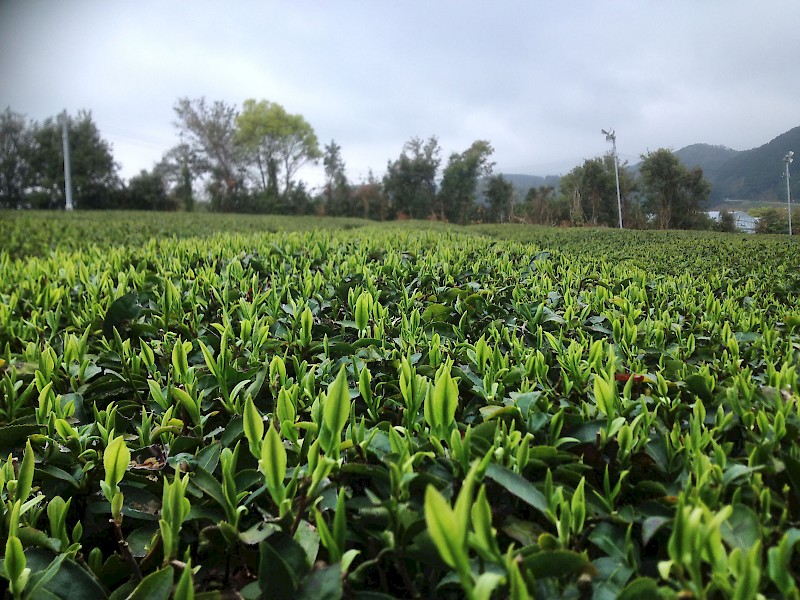
Mr. Matsumoto's tea garden parcel for the Shincha MOE on 8th April 2017
As you can see in this picture, rainy weather predominates at the moment and it is relatively chilly, too. So, this year’s harvest of Shincha MOE will certainly not take place before 20th April, as it did last year, but rather at the end of April.
Of course, Mr. Matsumoto harvests only the young sprouts, which are well visible in this picture because of their light green colour, for the Shincha MOE. Older leaves, which are distinctly darker, larger and firmer, are not harvested. By the way, MOE means ’spring green’ and depicts exactly the colour of the young sprouts that are harvested for the Shincha MOE.
6th April 2017 - Preparations for Kabuse Shincha at Mankichi Watanabe’s tea garden in Yakushima Island
Meanwhile, the preparations at the organic tea garden of the Watanabe family for the Kabuse Shincha are in full swing. Yesterday Mrs. Goto, who works with Mr. Watanabe, already sent us photos, taken for us by Mankichi’s son Keita Watanabe in his tea garden.
Watanabe Kabuse Shincha 2017
The island Yakushima lies deep in the South of Japan, even further south of Kyushu Island than the other producing regions in the prefecture Kagoshima. It is located approximately 200km south of the city Kagoshima. In Yakushima, the tea bushes are nationwide the first to sprout. So, Yakushima is, in a manner of speaking, an oasis for the tea sort Shincha.
In the picture taken by Mankichi Watanabe’s son on 4th April, you can see not only that the tea bushes for the Kabuse Shincha are already being shaded with black nets – half of the work of affixing the nets is done. You can also see that at this early time the young sprouts are already well visible. Additionally, the tea garden’s light green colour tells us that the tea bushes have begun to sprout by now and are visibly forming beautiful buds, which will be used for the Watanabe Kabuse Shincha 2017.
All the more astonishing is that the tea garden parcel which you can see in the picture, is the one where the bushes for the tea varietal Asatsuyu are cultivated, because these bushes aren’t even the first ones to sprout at Watanabe tea garden. No, the tea bush variety Kuritawase begins even earlier to form new sprouts and buds. So, it won’t be long until Watanabe Kabuse Shincha 2017 can be harvested!
3rd April 2017 - The temporal border of Shincha: From Yakushima to Shizuoka
While with some sorts of tea name, analysis can be quite confusing, in the case of Shincha it can be an exciting opportunity to look behind the scenes. The key of all considerations lies of course within the first syllable of Shincha, ’shin’, meaning simply ’new’. With Shincha it is, of course, all about the first fresh teas of the new harvest year. But when are they harvested in which region?
Two years ago we were lucky to experience a very early Shincha year. This was thanks to weather conditions and the fact that we were in the right place at the right time. Already in late March we could experience the Shincha harvest at Mankichi Watanabe’s tea garden in Yakushima Island, which is located 200km south from Kagoshima and thus even more south than Tanegashima Island. Both islands, Yakushima and Tanegashima, are part of the prefecture Kagoshima, even though the main part of this prefecture is located at the island Kyushu, far away from Yakushima.
While the Shincha harvest at Mankichi Watanabe’s tea garden in 2015 started as early as late March, the harvest in the Kirishima region took place approximately three weeks later. That sounds quite surprising given the fact that it's still the same prefecture. Shutaro Hayashi harvested his first tea of the first harvest (Tennen Gyokuro) around the 20th April. However, in the nearby prefecture Miyazaki, the first harvest of the Morimoto Shincha at Haruyo and Shigeru Morimoto’s tea garden took place only shortly before that. This can be explained by the strong solar radiation in Miyazaki, for which it is well-known.
However, what really surprised us was the fact that in the last years a Shincha from Shizuoka came into the European market nearly at the same time as the sorts of Shincha from the southernmost end of Japan (that means Kyushu with the prefectures Kagoshima, Miyazaki and Kumamoto among others). How is this possible? Since Shizuoka lies around 1000 km further in the North than Yakushima, just a bit south from Tokyo, shouldn’t the harvest have taken place at least four to six weeks later?
An explanation which made us smile came from Shutaro Hayashi, who has an exciting network within the Japanese insider tea scene, thanks to his studies in Kagoshima. These insider contacts often reveal surprising facts: A Shincha can certainly come into the market shortly after the harvest in Yakushima and Tanegashima, even if the harvest there did not even take place. Well, but how so?
There are at least two possible explanations: First, there are countless wholesalers and final producers of tea (’Tonya-san’ in Japanese), who purchase leaves from all over Japan and sell them with a ’fitting’ name. For them, the lable ’Shizuoka Shincha’ does not necessarily mean that the harvested leaves have to be from Shizuoka, but that only the final processing must have happened in Shizuoka. That’s an interesting way of interpretation, which doubtless has its justification, but does not really seem to fit with our own philosphy of tea.
The second possible explanation is quite surprising, too: You can of course also deep freeze the pre-processed tea leaves (Aracha) from the last harvest and then do the final processing just shortly before the upcoming harvest in other regions. So you are the first to bring Shincha into the market, whenever the new harvest takes place!
Frankly, our way of thinking is quite different. It is certainly nice to be able to enjoy a fresh Shincha at such an early time in the year. But isn’t the real charm of a Shincha about being harvested really fresh and not about just tasting fresh? And isn’t it also nice to know where the harvested Shincha leave material really comes from and to be able to witness how the Shincha is harvested at a certain tea garden whose character it will have?
Based on these thoughts this ’Shincha Blog 2017’ was born. Here we will post nearly every day about the latest news about the Shincha harvest, mostly events we experience together with our tea garden partners Mankichi Watanabe in Yakushima Island, Haruyo and Shigeru Morimoto in Miyazaki and Mr. Matsumoto in Kumamoto. In a few days there will be the first pictures from Yakushima!
29th March 2017 - Shincha 2017: Reservations confirmed by Watanabe, Morimoto and Matsumoto
In the last days we received really good news from Mr. Matsumoto, Haruyo and Shigeru Morimoto and from Mrs. Goto, who works for family Watanabe's tea garden: All three of them confirmed this year's reservations of Shincha. So this year (2017) too, chances are good for getting sorts of Shincha as great as we got in the past years.
Making Shincha, you harvest leaves from tea bushes that sprout quite early. For these, the Morimoto family use especially the tea bush variety Yutaka Midori, which is shaded for nearly two weeks. As for the Watanabe family in Yakushima, the bush which sprouts earliest is the rare tea bush variety Kuritawase, which is also shaded for the Shincha harvest.
Mr. Matsumoto on the other hand uses his Yabukita bushes, which do not sprout so early, but he harvests only the youngest and finest leaves. This way he can still harvest quite early and also produce a very special and very fine quality of Shincha. The downside of such finely harvested leaves, which are used for Mr. Matsumoto's Shincha MOE, is that the amount of harvested leaves is extremely small. Therefore we are very thankful that Mr. Matsumoto confirmed our reservation again this year, even though the quantity of the Shincha Moe produced is not very big.
The Kabuse Shincha produced by the Watanabe family is highly limited, too. In this case it is less due to the small harvest quantity, but more due to the fact that Mr. Watanabe produces a special Kabuse Shincha exclusively for us. For this exclusive Shincha he uses the leaves of his rare Sae Midori bushes. Since he only has five rows of Sae Midori bushes in his organic tea garden, the harvest quantity is only about 15kg. Needless to say, we do not want to take all of the 15kg away from Mr. Watanabe. So, we only expect about 5kg leave material of the sort Sae Midori for our Watanabe Kabuse Shincha. That's why it is not possible to produce more than 35kg of this Shincha, otherwise the proportion of the single varieties in the final Shincha would change too much. So, this too is a treasured sort of Shincha and every year we are happy and grateful that Mr. Watanabe produces this tea for us.


